智能汽车中英文对照外文翻译文献
- 格式:doc
- 大小:1.17 MB
- 文档页数:37
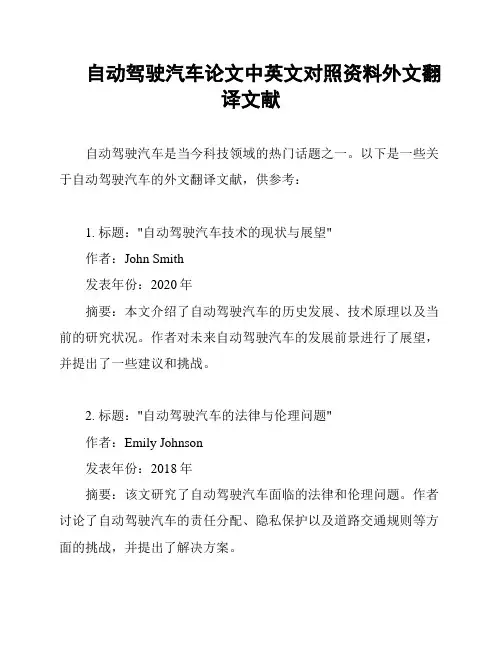
自动驾驶汽车论文中英文对照资料外文翻
译文献
自动驾驶汽车是当今科技领域的热门话题之一。
以下是一些关于自动驾驶汽车的外文翻译文献,供参考:
1. 标题:"自动驾驶汽车技术的现状与展望"
作者:John Smith
发表年份:2020年
摘要:本文介绍了自动驾驶汽车的历史发展、技术原理以及当前的研究状况。
作者对未来自动驾驶汽车的发展前景进行了展望,并提出了一些建议和挑战。
2. 标题:"自动驾驶汽车的法律与伦理问题"
作者:Emily Johnson
发表年份:2018年
摘要:该文研究了自动驾驶汽车面临的法律和伦理问题。
作者讨论了自动驾驶汽车的责任分配、隐私保护以及道路交通规则等方面的挑战,并提出了解决方案。
3. 标题:"自动驾驶汽车的安全性分析"
作者:David Brown
发表年份:2019年
摘要:本文通过对自动驾驶汽车的安全性进行分析,评估了其在各种情况下的表现和风险。
作者提出了一些改进措施,以提高自动驾驶汽车的安全性和稳定性。
以上是一些关于自动驾驶汽车的翻译文献,它们可以帮助研究者了解该领域的最新发展和挑战,为相关论文的撰写提供参考。
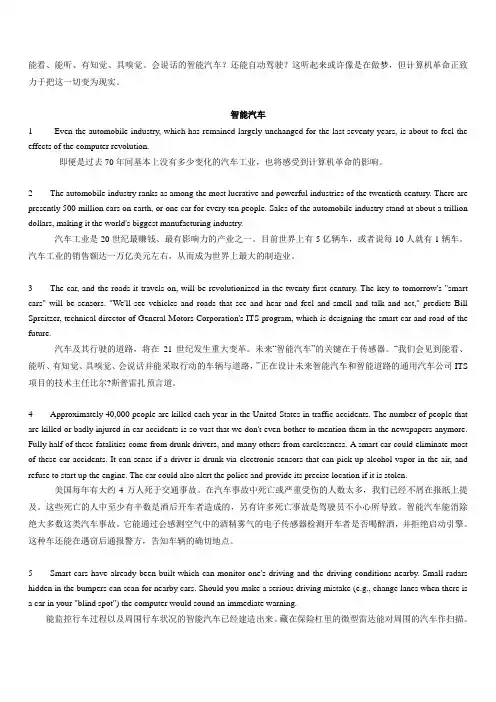
能看、能听、有知觉、具嗅觉、会说话的智能汽车?还能自动驾驶?这听起来或许像是在做梦,但计算机革命正致力于把这一切变为现实。
智能汽车1 Even the automobile industry, which has remained largely unchanged for the last seventy years, is about to feel the effects of the computer revolution.即便是过去70年间基本上没有多少变化的汽车工业,也将感受到计算机革命的影响。
2 The automobile industry ranks as among the most lucrative and powerful industries of the twentieth century. There are presently 500 million cars on earth, or one car for every ten people. Sales of the automobile industry stand at about a trillion dollars, making it the world's biggest manufacturing industry.汽车工业是20世纪最赚钱、最有影响力的产业之一。
目前世界上有5亿辆车,或者说每10人就有1辆车。
汽车工业的销售额达一万亿美元左右,从而成为世界上最大的制造业。
3 The car, and the roads it travels on, will be revolutionized in the twenty-first century. The key to tomorrow's "smart cars" will be sensors. "We'll see vehicles and roads that see and hear and feel and smell and talk and act," predicts Bill Spreitzer, technical director of General Motors Corporation's ITS program, which is designing the smart car and road of the future.汽车及其行驶的道路,将在21世纪发生重大变革。
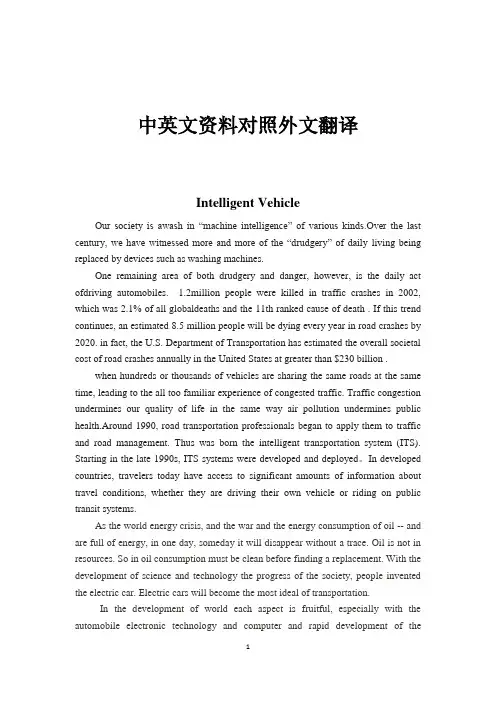
中英文资料对照外文翻译Intelligent VehicleOur society is awash in “machine intelligence” of various kinds.Over the last century, we have witnessed more and more of the “drudgery” of daily living being replaced by devices such as washing machines.One remaining area of both drudgery and danger, however, is the daily act ofdriving automobiles. 1.2million people were killed in traffic crashes in 2002, which was 2.1% of all globaldeaths and the 11th ranked cause of death . If this trend continues, an estimated 8.5 million people will be dying every year in road crashes by 2020. in fact, the U.S. Department of Transportation has estimated the overall societal cost of road crashes annually in the United States at greater than $230 billion .when hundreds or thousands of vehicles are sharing the same roads at the same time, leading to the all too familiar experience of congested traffic. Traffic congestion undermines our quality of life in the same way air pollution undermines public health.Around 1990, road transportation professionals began to apply them to traffic and road management. Thus was born the intelligent transportation system (ITS). Starting in the late 1990s, ITS systems were developed and deployed。
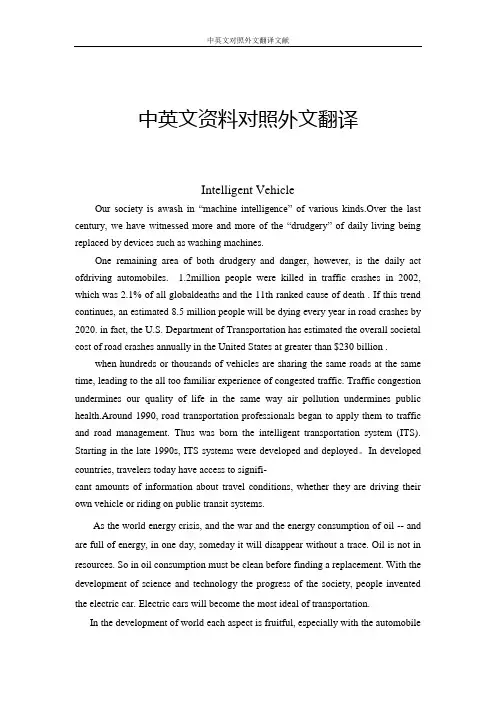
中英文资料对照外文翻译Intelligent VehicleOur society is awash in “machine intelligence” of various kinds.Over the last century, we have witnessed more and more of the “drudgery” of daily living being replaced by devices such as washing machines.One remaining area of both drudgery and danger, however, is the daily act ofdriving automobiles. 1.2million people were killed in traffic crashes in 2002, which was 2.1% of all globaldeaths and the 11th ranked cause of death . If this trend continues, an estimated 8.5 million people will be dying every year in road crashes by 2020. in fact, the U.S. Department of Transportation has estimated the overall societal cost of road crashes annually in the United States at greater than $230 billion .when hundreds or thousands of vehicles are sharing the same roads at the same time, leading to the all too familiar experience of congested traffic. Traffic congestion undermines our quality of life in the same way air pollution undermines public health.Around 1990, road transportation professionals began to apply them to traffic and road management. Thus was born the intelligent transportation system (ITS). Starting in the late 1990s, ITS systems were developed and deployed。
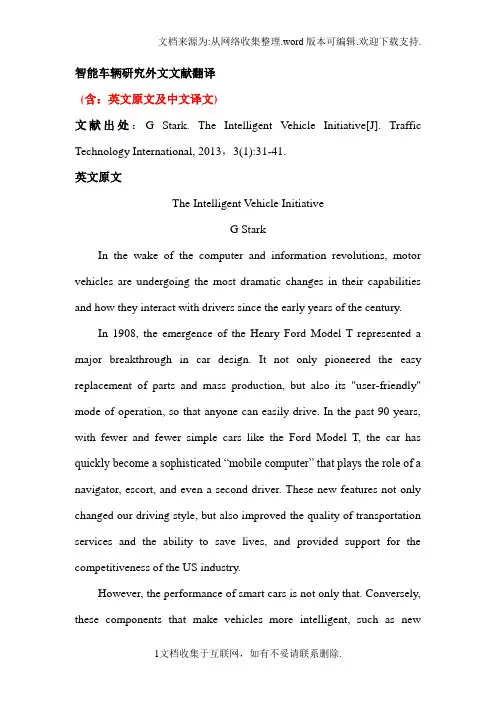
智能车辆研究外文文献翻译(含:英文原文及中文译文)文献出处:G Stark. The Intelligent Vehicle Initiative[J]. Traffic Technology International, 2013,3(1):31-41.英文原文The Intelligent Vehicle InitiativeG StarkIn the wake of the computer and information revolutions, motor vehicles are undergoing the most dramatic changes in their capabilities and how they interact with drivers since the early years of the century.In 1908, the emergence of the Henry Ford Model T represented a major breakthrough in car design. It not only pioneered the easy replacement of parts and mass production, but also its "user-friendly" mode of operation, so that anyone can easily drive. In the past 90 years, with fewer and fewer simple cars like the Ford Model T, the car has quickly become a sophisticated “mobile computer” that plays the role of a navigator, escort, and even a second driver. These new features not only changed our driving style, but also improved the quality of transportation services and the ability to save lives, and provided support for the competitiveness of the US industry.However, the performance of smart cars is not only that. Conversely, these components that make vehicles more intelligent, such as newinformation, safety and automation technologies, arrive on the market as spare parts, or as optional equipment, or as special accessories for after-sales services. In order to improve driver safety, these technologies have been continuously developed and put on the market. However, individual technologies have not yet been integrated and they cannot create fully intelligent vehicles that are highly collaborative with drivers.The automotive industry has realized and solved the influx of potential uncoordinated technologies. But their progress is hindered by technical and economic barriers, uncertain consumer preferences, and imperfect standards and guidelines. In addition, neither traditional car manufacturers nor government regulators (unless the security issues are obvious) can control the use of aftermarket products, especially in the use o f trucks and buses. However, there is no “people-oriented” smart vehicle that attempts to integrate and coordinate various technologies to solve problems. We may not only lose the opportunity to implement new in-vehicle technology, but may even unintentionally reduce the safety and performance of driving.Recognizing the importance of intelligent vehicles and the potential dangers of human factors in vehicle design, the Ministry of Transport launched the Intelligent Vehicles Initiative (IVI) in 1997. This initiative aims to accelerate the development and integration of automotive systems to help cars, trucks and bus drivers operate more safely and effectively.The 1980s TV series “Knight Ranger” features smart vehicles that can cross over tall buildings, seem to drive the supersonic itself, spy on bad guys, and have English words and housekeepers. This car is not only smart but smart. Although smart vehicles in the real world will not be able to fly over traffic, they will have strong capabilities. As envisioned by the International Vaccine Research Institute, smart vehicles will be able to provide route instructions, feel objects, warn drivers that collisions will occur, auto signals help drivers stay alert in emergency situations, and may eventually be able to take over driving.The computer-based technology of information and motor vehicles, however, is not a new use. A wide range of automotive computers began the 1980s with the aim of improving vehicle operation and driver comfort. These technologies include the electronic control of the performance of fuel injection engines, especially the reduction of vehicle emissions, improved fuel economy, anti-lock braking systems to help drivers maintain control over slippery roads, and cruise control systems to reduce driver's driving for a long period of time. tedious. And these technologies are mainly to strengthen the vehicle, the latest wave in vehicle technology, of which the most interested is the purpose of the IVI's capabilities, and is intelligent transportation systems designed to strengthen the capabilities of the driver. These systems include early warning and information, driving assistance and automation technology.Research Plan The original research plan for the Mack IVI FOT included requirements to install the LDWS, TSA, and ACN systems on a test fleet of 36 tanker trucks operated by McKenzie Tank Lines in normal revenue service over a 19-month period. The final research plan was a revision of the original plan, because several technical problems with the data-acquisition and transmission systems delayed the start of the FOT. This in turn created logistical problems with the installation of systems and deployment of trucks in the test fleet. Consequently, the FOT was performed over a 12-month period, with a primary focus on the safety benefits of the LDWS, which was installed on 22 trucks. Since the Eaton VORAD (EVT-300) collision warning system (CWS) was standard equipment on the McKenzie Tank Lines tractors used in the FOT, this system was active throughout the FOT. The CWS was not disabled during the FOT, because driving with the CWS was considered to be valid baseline driving for McKenzie Tank Lines drivers, and it would be difficult to separate the effects of removing the CWS and adding the LDWS. All trucks were also equipped with data acquisition and communications equipment. LDWS Evaluation. Use of the LDWS was expected to affect driving performance in two ways. First, there is the immediate effect of warning the driver of a potential lane excursion, which gives the driver an opportunity to change his or her driving behavior before making a large lane excursion. Second, after gainingexperience using the LDWS, the driver’s overall driving performance may improve even without the use of the system. Another possibility is that a driver’s driving performance may decline when the system is disabled, because the driver may become dependent on the system. Three conditions were compared in the experimental design: ♦Phase I –Baseline Period: Data collected during this period would characterize the driving behavior of drivers who were not receiving LDWS feedback.♦ Phase II – Active Period: Data collected during this period would characterize the driving behavior of drivers receiving LDWS feedback.♦ Phase III – Post-Active Period: Data collected during this period would characterize the driving behavior of drivers after the LDWS feedback had been deactivated.Just as people have different professional capabilities, different types and levels of vehicle-mounted smart vehicle technology give “intelligence” to complement this driver. The driver information system expands the knowledge of the driver's route and location. Early warning systems, such as collision avoidance techniques, improve the driver's perception of what is happening in the surrounding environment. Automate and drive technical assistance and simulate the driver's thoughts and actions to actual operations or in case of emergency, long-term vehicles are temporary. However, in smart vehicles will expand the driver's ability, it may also increase the driver's traditional role. Inparticular, within the technology of the new car, the role of the person is expanded from sensory motor skills, writes Thomas Sheridan, professor who is responsible for the Human Machine Systems Laboratory at the Massachusetts Institute of Technology (MIT), "this plan, Programmers, ITS studies in automation, diagnosticians, monitoring learners and managers show the feasibility of the benefits of many technologies that will be applied in smart vehicles.The route guidance system will help drivers to better drive in unfamiliar streets or Finding the fastest route to their destination In 1992 and 1993, field trials conducted by the Department of Transportation at Orlando TravTek showed that a tourist-guided vehicle equipped with a route guidance system reduced the problem of 30% of vehicles turning the wrong corner. Compared with tourists with paper maps, it saves 20% of the time.The collision avoidance system can strengthen traffic safety regulations and completely prevent traffic accidents. According to studies, if drivers can respond for more than half a second, they can avoid 60% of the time. Road traffic accidents and 30% of head-on collisions, and 75% of vehicle accidents are caused by driver's devastation.The National Highway Traffic Safety Administration (NHTSA) estimates that each year The country’s use of these three types of collision avoidance system can avoid 1.1 million traffic accidents and account for 17% of the total number of traffic accidents, which can save 17,500 lives (belt and airbags save about10,500 people) and restore 26 billion US dollars. The other safety facilities are under test, including the automatic collision notification system. When the airbag of a car pops up, the system will automatically send a distress signal, and the drowsy driver warning system can prevent the driver from getting drowsy while the car is driving. To sleep.The in-vehicle automation system can take over driving in case of an emergency or autopilot if it allows long periods of driving. In 1996, the National Highway Traffic Safety Administration began field testing an intelligent cruise control system that can automatically adjust the vehicle's speed to maintain a safe distance from the vehicle in front of it to assess the safety impact of this technology. The more dramatic scene appeared in the drive called "Let's open your hands and let your feet go." Last summer, the National Association of Autonomous Highway Systems (NAHSC), jointly organized by the Ministry of Transport and nine other public and private organizations, demonstrated a prototype of a future fully-automated vehicle on a 12-km section of the I-15 road in Santiago. In the future, the automatic road management system will increase the supervision of traffic managers by 2-3 times at higher speeds and shorter distances. The system may also eliminate the occurrence of human-induced traffic accidents and improve road safety.In addition to providing passengers with safe and efficient transportation, the federal government expects that the inherentdevelopment trend of smart cars may also increase the economic competitiveness of the United States.In order for smart cars to reach their maximum potential, they must be able to communicate with intelligent transportation infrastructure systems and other smart cars. For example, communicating with intelligent infrastructure systems can enable smart cars to understand the occurrence of accidents and then actively choose routes in real time. . The smart car can also act as a probe and send information about the road conditions to the intelligent infrastructure system to create richer road conditions basic information. In addition, fully automated vehicles should also be able to rely, to some extent, on the guidance provided by intelligent infrastructure systems and other smart cars. For example, not long ago, the American Helicopter Association (AHS) in San Diego showed that an automatic car equipped with a magnetic sensor under a bumper was successfully guided by a 1.2 m magnet implanted under the surface of the road.In the next 5 to 10 years, we should be able to see the first generation of products with special drive information and alarm system capabilities. With the development of information these systems will be increasingly perfect. Although the anti-collision system will provide some automatic assistance, drivers still have full control of the car. In addition, because of the initial communication capabilities with the intelligentinfrastructure system, the car will be more intelligent in terms of real-time detection of road conditions.In about 10 to 15 years, the application of some improvement measures will bring us better and smarter second-generation products. Although the driver still has full control of the car, the collision avoidance system will be able to take temporary control in emergency situations. In addition, more sophisticated voice recognition systems will be incorporated into the driver's interaction with the car. Vehicles can communicate with each other to improve their anti-collision ability. Of course, communication with intelligent infrastructure systems will also be more active and effective.In about 20 years, in the third generation of products, we will be able to see fully automated road systems, integrated systems for vehicles and infrastructure, and closer interaction between drivers and cars, such as the use of visual enhancements and visual displays.Looking back at a century of flooding technology, cars stand out as a particularly dynamic invention. In the next century, this vitality will promote the development of information and computer technology. Our next challenge is to integrate new information, security and automation technologies to create people-oriented smart vehicles that improve safety, ground drive efficiency and economic competitiveness.中文译文智能车辆研究G Stark本世纪初期,在计算机和信息革命的影响下,汽车经历了性能和与驾驶者之间的互动方面最富戏剧性的变革。

智能车外文文献翻译(原文+中文)Intelligent Vehicle Our society is awash in “machine intelligence” of various kinds.Over the last century, we have witnessed more and more of the “drudgery” of daily living being replaced by devices such as washing machinesOne remaining area of both drudgery and danger, however, is the daily act ofdriving automobiles1.2million people were killed in traffic crashes in 2002, which was 2.1% of all globaldeaths and the 11th ranked cause of deathIf this trend continues, an estimated 8.5 million people will be dying every year in road crashes by 2020. in fact, the U.S. Department of Transportation has estimated the overall societal cost of road crashes annually in the United States at greater than $230 billion when hundreds or thousands of vehicles are sharing the same roads at the same time, leading to the all too familiar experience of congested traffic. Traffic congestion undermines our quality of life in the same way air pollution undermines public health.Around 1990, road transportation professionals began to apply them to traffic and road management. Thus was born the intelligent transportation system ITS. Starting in the late 1990s, ITS systems were developed and deployed。
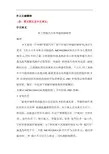
外文文献翻译(含:英文原文及中文译文)中文译文基于智能汽车的智能控制研究摘要本文使用一个叫做“智能汽车” 的平台进行智能控制研究,该小车采用飞思卡尔半导体公司制造的MC9S12DG128芯片作为主要的控制单元,同时介绍了最小的智能控制系统的设计和实现智能车的自我追踪驾驶使用路径识别算法。
智能控制智能车的研究包括:提取路径信息, 自我跟踪算法实现和方向和速度控制。
下文介绍了系统中不同模块的各自实现功能,最重要部分是智能车的过程智能控制:开环控制和闭环控制的应用程序包括增量式PID 控制算法和鲁棒控制算法。
最后一步是基于智能控制系统的智能测试。
关键词:MC9S12DG128;智能控制; 开环控制; PID ;鲁棒;1 研究背景随着控制理论的提高以及信息技术的快速发展, 智能控制在我们的社会中发挥着越来越重要的作用。
由于嵌入式设备有小尺寸、低功耗、功能强大等优点,相信在这个领域将会有一个相对广泛的应用, 如汽车电子、航空航天、智能家居。
如果这些技术一起工作,它将会蔓延到其他领域。
为了研究嵌入式智能控制技术,“智能汽车”被选为研究平台, 并把MC9S12DG128芯片作为主控单元。
通过智能控制, 智能汽车可以自主移动, 同时跟踪的路径。
首先, 本文给读者一个总体介绍智能车辆系统的[2、3]。
然后, 根据智能车辆的智能控制:提取路径信息, 自我跟踪算法实现中, 舵机的方向和速度的控制。
它提供包括了上述四个方面的细节的智能车系统信息。
此外, 本文强调了智能车的控制过程应用程序包括开环控制、闭环增量PID 算法和鲁棒算法。
2 智能车系统的总体设计该系统采用MC9S12DG128[4]作为主芯片,以及一个CCD 传感器作为交通信息收集的传感器。
速度传感器是基于无线电型光电管的原理开发。
路径可以CCD 传感器后绘制收集的数据,并且系统计算出相应的处理。
在同时,用由电动马达速度测试模块测量的智能汽车的当前速度进行响应的系统。
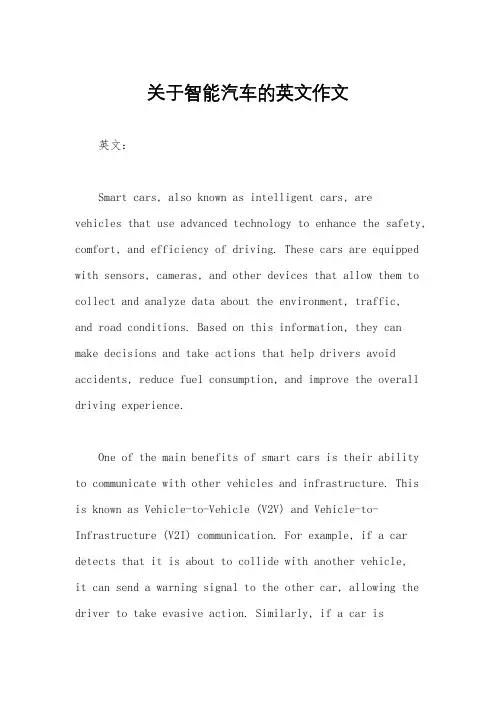
关于智能汽车的英文作文英文:Smart cars, also known as intelligent cars, arevehicles that use advanced technology to enhance the safety, comfort, and efficiency of driving. These cars are equipped with sensors, cameras, and other devices that allow them to collect and analyze data about the environment, traffic,and road conditions. Based on this information, they can make decisions and take actions that help drivers avoid accidents, reduce fuel consumption, and improve the overall driving experience.One of the main benefits of smart cars is their ability to communicate with other vehicles and infrastructure. This is known as Vehicle-to-Vehicle (V2V) and Vehicle-to-Infrastructure (V2I) communication. For example, if a car detects that it is about to collide with another vehicle,it can send a warning signal to the other car, allowing the driver to take evasive action. Similarly, if a car isapproaching a red light, it can receive a signal from the traffic light and adjust its speed accordingly, reducing the need for sudden braking and accelerating.Smart cars also have advanced driver assistance systems (ADAS) that can help drivers stay safe and avoid accidents. These systems include features such as lane departure warning, blind spot detection, and automatic emergency braking. They use sensors and cameras to monitor the vehicle's surroundings and provide alerts or take action when necessary. For example, if a driver starts to drift out of their lane, the car can sound an alarm or even steer itself back into the correct lane.In addition to safety features, smart cars also offer a range of convenience and entertainment features. For example, they can connect to the internet and provide access to music, news, and other services. They can also use voice recognition technology to allow drivers tocontrol various functions without taking their hands off the wheel or their eyes off the road.Overall, smart cars are a significant advancement inthe automotive industry. They offer a range of benefitsthat can enhance the driving experience and improve safety on the roads.中文:智能汽车,也称为智能车辆,是利用先进技术提高驾驶安全性、舒适性和效率的车辆。
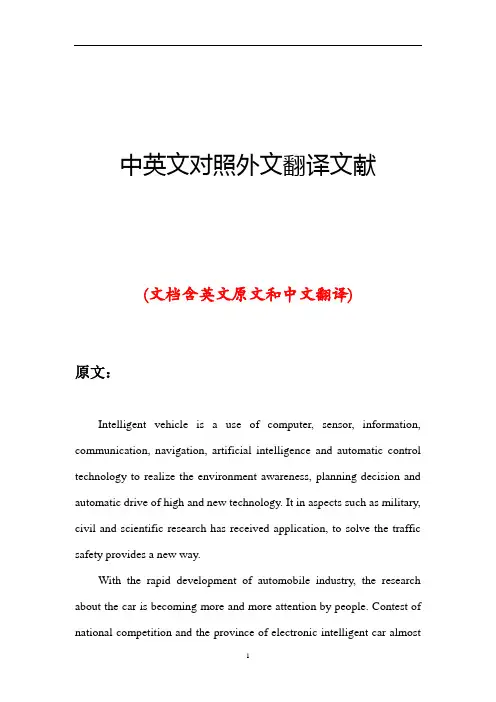
中英文对照外文翻译文献(文档含英文原文和中文翻译)原文:Intelligent vehicle is a use of computer, sensor, information, communication, navigation, artificial intelligence and automatic control technology to realize the environment awareness, planning decision and automatic drive of high and new technology. It in aspects such as military, civil and scientific research has received application, to solve the traffic safety provides a new way.With the rapid development of automobile industry, the research about the car is becoming more and more attention by people. Contest of national competition and the province of electronic intelligent car almostevery time this aspect of the topic, the national various universities are also attaches great importance to research on the topic, many countries have put the electronic design competition as a strategic means of innovative education. Electronic design involving multiple disciplines, machinery and electronics, sensor technology, automatic control technology, artificial intelligent control, computer and communication technology, etc., is a high-tech in the field of many. Electronic design technology, it is a national high-tech instance is one of the most important standard, its research significance is greatThe design though just a demo model, but is full of scientific and practical. First we according to the complex situation of road traffic, in accordance with the appropriate author to make a road model, including bend, straight and pavement set obstacles, etc. On curved and straight, the car along the orbit free exercise, when the small car meet obstacles, pulse modulation infrared sensors to detect the signal sent to the microcontroller, a corresponding control signal according to the program MCU control cars automatically avoid obstacles, to carry on the back, forward, turn left, turn rightSubject partsIntelligent vehicle is a concentration of environment awareness, planning decision, multi-scale auxiliary driving, and other functions in an integrated system, is an important part of intelligent transportation system.In military, civilian, space exploration and other fields has a broad application prospect. The design of smart car control system are studied, based on path planning is a process of the intelligent car control system2.1 theory is put forwardThe progress of science and technology of intelligent led products, but also accelerated the pace of development, MCU application scope of its application is increasingly wide, has gone far beyond the field of computer science. Small to toys, credit CARDS, big to the space shuttle, robots, from data acquisition, remote control and fuzzy control, intelligent systems with the human daily life, everywhere is dependent on the single chip microcomputer, this design is a typical application of single chip microcomputer. This design by implementing the driverless car, on the tests, by the reaction of the single chip microcomputer to control the car, make its become intelligent, automatic forward, turn and stop function, after continuing the perfection of this system also can be applied to road testing, security patrol, can meet the needs of society.In design, the use of the sensors to detect road surface condition, sensor central sea are faint and adopts a comparing amplifier amplification, and the signal input to the controller, the controlled end using stepper motor, because of the step motor is controlled electrical pulse, as long as the output from the controller to satisfy stepper motor merits of fixed control word. In operation of stepping motor and a drivingcircuit, it also to join a drive circuit in the circuit, each function module is different to the requirement of power supply current, the power supply part set up conversion circuit, so as to meet the needs of the various parts. After comparison choice element, design the circuit principle diagram and the circuit board, and do the debugging of hardware, system software and hardware is often the combination of organic whole. Software, on the use of the 51 single-chip timer interrupt to control pavement test interval and the car movement and speed. Due to take that road is simple, it is using more traditional assembly language for programming. For the correctness of the program design, using a commonly used keil c51 simulation software simulation validation, the last is integrated debugging of software and hardware, and prove the correctness and feasibility of the design scheme.2.2 electronic intelligent car design requirements(1) electric vehicles can be able to according to the course to run all the way; (2) electric vehicles can store and display the number of detected metal and sheet metal to the starting line in the distance; (3) are accurately electric cars after exercising all the way to the display of the electric vehicle the entire exercise time; (4) electric cars can't collisions with obstacles in the process of exercise.2.3 the general conception of computer network teaching websiteUsing 89 c51 as the car's control unit, sensor eight-way from outside,in the front of the car, as a black belt in the process of the car into the garage detecting element, at the rear end of the car when connected to eight-channel infrared sensors as the car pulled out of the garage of a black belt in detecting element, the LJ18A3-8 - Z/BX inductive proximity switch as garage iron detecting element, the microcontroller after receiving sensor detects the signal through the corresponding procedures to control the car forward, backward, turn, so that the car's performance indicators meet the requirements of the design.Intelligent car is a branch of intelligent vehicle research. It with the wheel as mobile mechanism, to realize the autonomous driving, so we call it the smart car. Smart car with the basic characteristics of the robot, easy to programming. It with remote control car the difference is that the latter requires the operator to control the steering, start-stop and in a more advanced remote control car can also control the speed (common model car belong to this type of remote control car); The smart car Is to be implemented by computer programming for the car stop, driving direction and speed control, without human intervention. Operator the smart car can be changed by a computer program or some data to change its drive type. This change can be controlled through programming, the characteristics of the car driving way is the biggest characteristic of smart car. The control system of smart car research purpose is to make the car driving with higher autonomy. If any given car a path, through the system,the car can get system for path after image processing of data moving and Angle (a), and can be scheduled path, according to the displacement and Angle information.The control system structure analysisAccording to the above design idea, the structure of the intelligent car control system can be divided into two layers1, the planning layerPC control system, the planning layer provides the information of the whole car driving, including path processing module and communication module. It has to solve the basic problem(1) using what tools to deal with the car path graph;(2) the car movement model is established, the data to calculate the car driving;(3) set up the car's motion model, the data to calculate the car driving;Layer 2, behaviorLower machine control system, the behavior is the underlying structure of a smart car control system, realize the real-time control of the car driving, it includes communication module, motor control module and data acquisition module. It to solve the basic problems are:(1) receiving, processing, PC sends data information;(2) the design of stepping motor control system;(3) information collection and the displacement and Angle of the car, car positioning posture, analysis system control error;The total design schemeSmart car control system are obtained by system structure, order process:(1) start AutoCAD, create or select a closed curve as the cart path, pick up the car starting $path graph(2) to choose the path of the graphics processing, make the car turning exist outside the minimum turning radius of edges and corners with circular arc transition(3) to generate a new path to simulate the motion process of car;(4) to calculate the displacement of the car driving need and wheel Angle, and then sends the data to the machine(5) under the machine after receiving data, through software programming control the rotation speed and Angle of the car wheels and make it according to the predetermined path A complete control system requirements closely linked to each function module in the system, according to the order process and the relationship between them, the total design scheme of the system is available.Design of basically has the following several modulesPart 1, the information acquisition module, data collection is composed of photoelectric detection and operation amplifier module,photoelectric detection were tracing test and speed test of two parts. To detect the signal after budget amplifier module lm324 amplifier plastic to single chip, its core part is several photoelectric sensor.2, control processing module: control processing module is a stc89c52 MCU as the core, the microcontroller will be collected from the information after the judgement, in accordance with a predetermined algorithm processing, and the handling results to the motor drive and a liquid crystal display module, makes the corresponding action.3, perform module: executable module consists of liquid crystal display (LCD), motor drive and motor, buzzer of three parts. LCD is mainly based on the results of single chip real-time display, convenient and timely users understand the current state of the system, motor driver based on single chip microcomputer instruction for two motor movements, can according to need to make the corresponding acceleration, deceleration, turning, parking and other movements, in order to achieve the desired purpose. Buzzer is mainly according to the requirements in a particular position to make a response to the report.译文一、引言智能车辆是一个运用计算机、传感、信息、通信、导航、人工智能及自动控制等技术来实现环境感知、规划决策和自动行驶为一体的高新技术综合体。
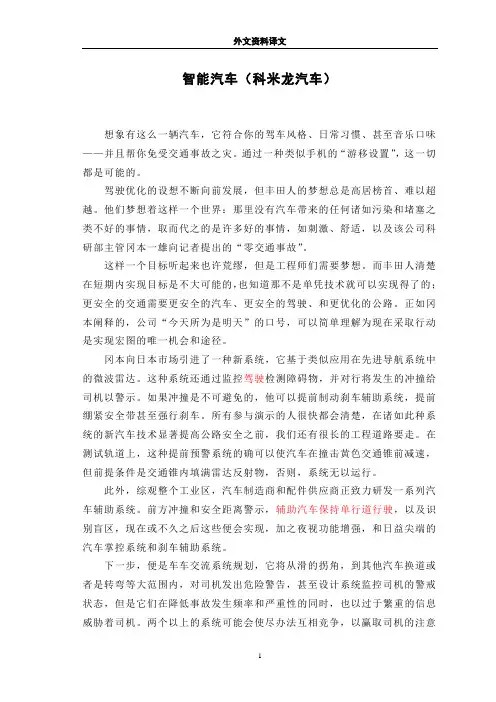
智能汽车(科米龙汽车)想象有这么一辆汽车,它符合你的驾车风格、日常习惯、甚至音乐口味——并且帮你免受交通事故之灾。
通过一种类似手机的“游移设置”,这一切都是可能的。
驾驶优化的设想不断向前发展,但丰田人的梦想总是高居榜首、难以超越。
他们梦想着这样一个世界:那里没有汽车带来的任何诸如污染和堵塞之类不好的事情,取而代之的是许多好的事情,如刺激、舒适,以及该公司科研部主管冈本一雄向记者提出的“零交通事故”。
这样一个目标听起来也许荒缪,但是工程师们需要梦想。
而丰田人清楚在短期内实现目标是不大可能的,也知道那不是单凭技术就可以实现得了的;更安全的交通需要更安全的汽车、更安全的驾驶、和更优化的公路。
正如冈本阐释的,公司“今天所为是明天”的口号,可以简单理解为现在采取行动是实现宏图的唯一机会和途径。
冈本向日本市场引进了一种新系统,它基于类似应用在先进导航系统中的微波雷达。
这种系统还通过监控驾驶检测障碍物,并对行将发生的冲撞给司机以警示。
如果冲撞是不可避免的,他可以提前制动刹车辅助系统,提前绷紧安全带甚至强行刹车。
所有参与演示的人很快都会清楚,在诸如此种系统的新汽车技术显著提高公路安全之前,我们还有很长的工程道路要走。
在测试轨道上,这种提前预警系统的确可以使汽车在撞击黄色交通锥前减速,但前提条件是交通锥内填满雷达反射物,否则,系统无以运行。
此外,综观整个工业区,汽车制造商和配件供应商正致力研发一系列汽车辅助系统。
前方冲撞和安全距离警示,辅助汽车保持单行道行驶,以及识别盲区,现在或不久之后这些便会实现,加之夜视功能增强,和日益尖端的汽车掌控系统和刹车辅助系统。
下一步,便是车车交流系统规划,它将从滑的拐角,到其他汽车换道或者是转弯等大范围内,对司机发出危险警告,甚至设计系统监控司机的警戒状态,但是它们在降低事故发生频率和严重性的同时,也以过于繁重的信息威胁着司机。
两个以上的系统可能会使尽办法互相竞争,以赢取司机的注意力。

智能车辆研究外文文献翻译(含:英文原文及中文译文)文献出处:G Stark. The Intelligent Vehicle Initiative[J]. Traffic Technology International, 2013,3(1):31-41.英文原文The Intelligent Vehicle InitiativeG StarkIn the wake of the computer and information revolutions, motor vehicles are undergoing the most dramatic changes in their capabilities and how they interact with drivers since the early years of the century.In 1908, the emergence of the Henry Ford Model T represented a major breakthrough in car design. It not only pioneered the easy replacement of parts and mass production, but also its "user-friendly" mode of operation, so that anyone can easily drive. In the past 90 years, with fewer and fewer simple cars like the Ford Model T, the car has quickly become a sophisticated “mobile computer” that plays the role of a navigator, escort, and even a second driver. These new features not only changed our driving style, but also improved the quality of transportation services and the ability to save lives, and provided support for the competitiveness of the US industry.However, the performance of smart cars is not only that. Conversely, these components that make vehicles more intelligent, such as newinformation, safety and automation technologies, arrive on the market as spare parts, or as optional equipment, or as special accessories for after-sales services. In order to improve driver safety, these technologies have been continuously developed and put on the market. However, individual technologies have not yet been integrated and they cannot create fully intelligent vehicles that are highly collaborative with drivers.The automotive industry has realized and solved the influx of potential uncoordinated technologies. But their progress is hindered by technical and economic barriers, uncertain consumer preferences, and imperfect standards and guidelines. In addition, neither traditional car manufacturers nor government regulators (unless the security issues are obvious) can control the use of aftermarket products, especially in the use o f trucks and buses. However, there is no “people-oriented” smart vehicle that attempts to integrate and coordinate various technologies to solve problems. We may not only lose the opportunity to implement new in-vehicle technology, but may even unintentionally reduce the safety and performance of driving.Recognizing the importance of intelligent vehicles and the potential dangers of human factors in vehicle design, the Ministry of Transport launched the Intelligent Vehicles Initiative (IVI) in 1997. This initiative aims to accelerate the development and integration of automotive systems to help cars, trucks and bus drivers operate more safely and effectively.The 1980s TV series “Knight Ranger” features smart vehicles that can cross over tall buildings, seem to drive the supersonic itself, spy on bad guys, and have English words and housekeepers. This car is not only smart but smart. Although smart vehicles in the real world will not be able to fly over traffic, they will have strong capabilities. As envisioned by the International Vaccine Research Institute, smart vehicles will be able to provide route instructions, feel objects, warn drivers that collisions will occur, auto signals help drivers stay alert in emergency situations, and may eventually be able to take over driving.The computer-based technology of information and motor vehicles, however, is not a new use. A wide range of automotive computers began the 1980s with the aim of improving vehicle operation and driver comfort. These technologies include the electronic control of the performance of fuel injection engines, especially the reduction of vehicle emissions, improved fuel economy, anti-lock braking systems to help drivers maintain control over slippery roads, and cruise control systems to reduce driver's driving for a long period of time. tedious. And these technologies are mainly to strengthen the vehicle, the latest wave in vehicle technology, of which the most interested is the purpose of the IVI's capabilities, and is intelligent transportation systems designed to strengthen the capabilities of the driver. These systems include early warning and information, driving assistance and automation technology.Research Plan The original research plan for the Mack IVI FOT included requirements to install the LDWS, TSA, and ACN systems on a test fleet of 36 tanker trucks operated by McKenzie Tank Lines in normal revenue service over a 19-month period. The final research plan was a revision of the original plan, because several technical problems with the data-acquisition and transmission systems delayed the start of the FOT. This in turn created logistical problems with the installation of systems and deployment of trucks in the test fleet. Consequently, the FOT was performed over a 12-month period, with a primary focus on the safety benefits of the LDWS, which was installed on 22 trucks. Since the Eaton VORAD (EVT-300) collision warning system (CWS) was standard equipment on the McKenzie Tank Lines tractors used in the FOT, this system was active throughout the FOT. The CWS was not disabled during the FOT, because driving with the CWS was considered to be valid baseline driving for McKenzie Tank Lines drivers, and it would be difficult to separate the effects of removing the CWS and adding the LDWS. All trucks were also equipped with data acquisition and communications equipment. LDWS Evaluation. Use of the LDWS was expected to affect driving performance in two ways. First, there is the immediate effect of warning the driver of a potential lane excursion, which gives the driver an opportunity to change his or her driving behavior before making a large lane excursion. Second, after gainingexperience using the LDWS, the driver’s overall driving performance may improve even without the use of the system. Another possibility is that a driver’s driving performance may decline when the system is disabled, because the driver may become dependent on the system. Three conditions were compared in the experimental design: ♦Phase I –Baseline Period: Data collected during this period would characterize the driving behavior of drivers who were not receiving LDWS feedback.♦ Phase II – Active Period: Data collected during this period would characterize the driving behavior of drivers receiving LDWS feedback.♦ Phase III – Post-Active Period: Data collected during this period would characterize the driving behavior of drivers after the LDWS feedback had been deactivated.Just as people have different professional capabilities, different types and levels of vehicle-mounted smart vehicle technology give “intelligence” to complement this driver. The driver information system expands the knowledge of the driver's route and location. Early warning systems, such as collision avoidance techniques, improve the driver's perception of what is happening in the surrounding environment. Automate and drive technical assistance and simulate the driver's thoughts and actions to actual operations or in case of emergency, long-term vehicles are temporary. However, in smart vehicles will expand the driver's ability, it may also increase the driver's traditional role. Inparticular, within the technology of the new car, the role of the person is expanded from sensory motor skills, writes Thomas Sheridan, professor who is responsible for the Human Machine Systems Laboratory at the Massachusetts Institute of Technology (MIT), "this plan, Programmers, ITS studies in automation, diagnosticians, monitoring learners and managers show the feasibility of the benefits of many technologies that will be applied in smart vehicles.The route guidance system will help drivers to better drive in unfamiliar streets or Finding the fastest route to their destination In 1992 and 1993, field trials conducted by the Department of Transportation at Orlando TravTek showed that a tourist-guided vehicle equipped with a route guidance system reduced the problem of 30% of vehicles turning the wrong corner. Compared with tourists with paper maps, it saves 20% of the time.The collision avoidance system can strengthen traffic safety regulations and completely prevent traffic accidents. According to studies, if drivers can respond for more than half a second, they can avoid 60% of the time. Road traffic accidents and 30% of head-on collisions, and 75% of vehicle accidents are caused by driver's devastation.The National Highway Traffic Safety Administration (NHTSA) estimates that each year The country’s use of these three types of collision avoidance system can avoid 1.1 million traffic accidents and account for 17% of the total number of traffic accidents, which can save 17,500 lives (belt and airbags save about10,500 people) and restore 26 billion US dollars. The other safety facilities are under test, including the automatic collision notification system. When the airbag of a car pops up, the system will automatically send a distress signal, and the drowsy driver warning system can prevent the driver from getting drowsy while the car is driving. To sleep.The in-vehicle automation system can take over driving in case of an emergency or autopilot if it allows long periods of driving. In 1996, the National Highway Traffic Safety Administration began field testing an intelligent cruise control system that can automatically adjust the vehicle's speed to maintain a safe distance from the vehicle in front of it to assess the safety impact of this technology. The more dramatic scene appeared in the drive called "Let's open your hands and let your feet go." Last summer, the National Association of Autonomous Highway Systems (NAHSC), jointly organized by the Ministry of Transport and nine other public and private organizations, demonstrated a prototype of a future fully-automated vehicle on a 12-km section of the I-15 road in Santiago. In the future, the automatic road management system will increase the supervision of traffic managers by 2-3 times at higher speeds and shorter distances. The system may also eliminate the occurrence of human-induced traffic accidents and improve road safety.In addition to providing passengers with safe and efficient transportation, the federal government expects that the inherentdevelopment trend of smart cars may also increase the economic competitiveness of the United States.In order for smart cars to reach their maximum potential, they must be able to communicate with intelligent transportation infrastructure systems and other smart cars. For example, communicating with intelligent infrastructure systems can enable smart cars to understand the occurrence of accidents and then actively choose routes in real time. . The smart car can also act as a probe and send information about the road conditions to the intelligent infrastructure system to create richer road conditions basic information. In addition, fully automated vehicles should also be able to rely, to some extent, on the guidance provided by intelligent infrastructure systems and other smart cars. For example, not long ago, the American Helicopter Association (AHS) in San Diego showed that an automatic car equipped with a magnetic sensor under a bumper was successfully guided by a 1.2 m magnet implanted under the surface of the road.In the next 5 to 10 years, we should be able to see the first generation of products with special drive information and alarm system capabilities. With the development of information these systems will be increasingly perfect. Although the anti-collision system will provide some automatic assistance, drivers still have full control of the car. In addition, because of the initial communication capabilities with the intelligentinfrastructure system, the car will be more intelligent in terms of real-time detection of road conditions.In about 10 to 15 years, the application of some improvement measures will bring us better and smarter second-generation products. Although the driver still has full control of the car, the collision avoidance system will be able to take temporary control in emergency situations. In addition, more sophisticated voice recognition systems will be incorporated into the driver's interaction with the car. Vehicles can communicate with each other to improve their anti-collision ability. Of course, communication with intelligent infrastructure systems will also be more active and effective.In about 20 years, in the third generation of products, we will be able to see fully automated road systems, integrated systems for vehicles and infrastructure, and closer interaction between drivers and cars, such as the use of visual enhancements and visual displays.Looking back at a century of flooding technology, cars stand out as a particularly dynamic invention. In the next century, this vitality will promote the development of information and computer technology. Our next challenge is to integrate new information, security and automation technologies to create people-oriented smart vehicles that improve safety, ground drive efficiency and economic competitiveness.中文译文智能车辆研究G Stark本世纪初期,在计算机和信息革命的影响下,汽车经历了性能和与驾驶者之间的互动方面最富戏剧性的变革。
Electric intelligent car based on SCMThe single slice machine is also called tiny controller, is because it was used in the industry to control realm at the earliest stage。
Single slice machine from inside chip have CPU appropriation processor to develop only since then。
At the earliest stage of design the principle is to pass to integrate a great deal of peripherals and CPU in a chip, making calculator system smaller, integrating more easily into complicated of but to mention to request a strict control equipments in the middle。
The INTEL Z80 is the processor which designed according to this kind of thought at the earliest stage, from now on, single slice the development of the machine and appropriation processor went by different roads then.The single slice of the earlier period all of machines are 8 or 4.Among them, the INTEL is most successful of 8031, because of in brief dependable but the function was quite good to acquire very big good opinion.Henceforth at 8031 up developed MCS51 serieses a single slice machine system。
无人驾驶汽车(智能汽车)无人驾驶汽车是一种智能汽车,也可以称之为轮式移动机器人,主要依靠车内的以计算机系统为主的智能驾驶仪来实现无人驾驶。
据汤森路透知识产权与科技最新报告显示,2010年到2015年间,与汽车无人驾驶技术相关的发明专利超过22,000件,并且在此过程中,部分企业已崭露头角,成为该领域的行业领导者。
研发历史从20世纪70年代开始,美国、英国、德国等发达国家开始进行无人驾驶汽车的研究,在可行性和实用化方面都取得了突破性的进展。
中国从20世纪80年代开始进行无人驾驶汽车的研究,国防科技大学在1992年成功研制出中国第一辆真正意义上的无人驾驶汽车。
2005年,首辆城市无人驾驶汽车在上海交通大学研制成功。
世界上最先进的无人驾驶汽车已经测试行驶近五十万公里,其中最后八万公里是在没有任何人为安全干预措施下完成的。
技术原理无人驾驶汽车是通过车载传感系统感知道路环境,自动规划行车路线并控制车辆到达预定目标的智能汽车。
它是利用车载传感器来感知车辆周围环境,并根据感知所获得的道路、车辆位置和障碍物信息,控制车辆的转向和速度,从而使车辆能够安全、可靠地在道路上行驶。
集自动控制、体系结构、人工智能、视觉计算等众多技术于一体,是计算机科学、模式识别和智能控制技术高度发展的产物,也是衡量一个国家科研实力和工业水平的一个重要标志,在国防和国民经济领域具有广阔的应用前景。
主要特点安全稳定安全是拉动无人驾驶车需求增长的主要因素。
每年,驾驶员们的疏忽大意都会导致许多事故。
既然驾驶员失误百出,汽车制造商们当然要集中精力设计能确保汽车安全的系统。
“无人”驾驶系统种类繁多,其中有些根本算不上“无人”,还有些活像是科幻小说中的东西。
防抱死制动系统其实就算无人驾驶系统。
虽然防抱死制动器需要驾驶员来操作但该系统仍可作为无人驾驶系统系列的一个代表,因为防抱死制动系统的部分功能在过去需要驾驶员手动实现。
不具备防抱死系统的汽车紧急刹车时,轮胎会被锁死,导致汽车失控侧滑。
中英文资料外文翻译(文档含英文原文和中文翻译)智能小车控制中模糊-PID控制的实现摘要:本文设计了一个自动智能小车控制系统和模糊-PID控制算法。
提出了一个设计模糊PID控制器的方案。
通过matlab的仿真分析表明,模糊- PID控制算法的性能比一般的PID控制更好。
智能小车的试验结果表明它会随黑色的引导线快速并且稳定的走完整个行程。
关键词:模糊PID;智能小车;模糊控制器;模糊控制。
1.简介近年来,许多国家正在研制无人驾驶的车辆技术。
产生了许多新的理论和应用技术。
文献[1]中提出了一个采用实时检测速度从而准确、动态改变小车转向的理论,从而实现转向完美特性的控制策略。
文献[2]中采用边缘检测算法来提取道路信息,并采用了比例控制。
文献[3]提出了一种有效、具有良好抗干扰性的、适应性强的动态图像处理算法。
这种算法有效的解决了由环境光线变化以及轨道变化所引起的小车偏离轨道现象。
文献[4]利用非线性最优化重建了轨道和摄像调整间的空间关系,从而使它能够精确的测量出横向偏差。
上述方案都从某种意义上改善了小车的性能,但他们都缺少以小车运动和大量实验为基础的小车的特性。
这篇文章中提出了一个模糊控制算法以及模糊PID控制器的设计方法。
在本文最后,给出了实验结果来证明模糊PID算法的有效性。
2.硬件系统设计要实现模糊PID控制算法的设计,有必要设计一个智能小车硬件系统。
智能小车应该有由道路检测,转角检测,速度检测等构成的智能控制单元。
详见图1。
图1 智能小车原理框图3.模糊PID控制的基本原则用一般的PID控制算法来获得最好的响应是不容易的。
因为参数Kp、Ki、Kd不适应于不同的对象,或者同一个对象的不同状态。
模糊控制是以模糊集合和模糊逻辑为机车的。
不需要精确的数学模型,它可以由用经验建立起来的规则表来确定控制变量的大小。
一般来说,模糊控制的输入变量基于系统的误差E和系统的误差变化量Ec。
这和比例-微分控制相似。
这样的控制可能可以获得较好的动态性能,但获得的静态性能不能让人满意。
中英文对照翻译附件1:翻译译文智能车辆本世纪初期,在计算机和信息革命的影响下,汽车经历了性能和与驾驶者之间的互动方面最富戏剧性的变革。
1908年,亨利福特T型车的出现体现了汽车设计上的重大突破。
它不仅开创了轻松更换零件和大量生产的先河,而且其“用户友好”的运作方式,让任何人都可以轻松驾驶。
近90年来,类似于福特T型车的简单汽车越来越少,汽车迅速成为了一种复杂的“移动电脑”,扮演着领航者,护航者,甚至第二司机的角色。
这些新特性不仅改变了我们的驾驶方式,还提高了运输服务质量和挽救生命的能力,并对美国工业的竞争力提供了支持。
然而,智能车的表现不仅如此。
相反的,使车辆更加智能的这些组件,如新信息,安全性和自动化技术,是作为零配件抵达市场的,或作为可选设备,或作为售后服务的特殊配件。
为了提高司机的安全性,这些技术不断发展并上市销售。
但是个别的技术还没有得到整合,不能创造出与司机高度协作的完全智能的车辆。
汽车行业已经意识到并解决了潜在的不协调技术的大量涌入问题。
但他们的进步受到技术和经济障碍,不确定的消费者喜好,不完善的标准和准则的阻碍。
此外,无论是传统的汽车制造商或是政府监管机构(除非安全问题非常明显)都不能控制售后的产品的使用,特别是在卡车和公共汽车的使用方面。
然而,还没有一个“以人为本”的智能车辆试图整合和协调各种技术以解决问题。
我们也许不仅仅会失去实现新的车载技术的机遇,甚至可能会在无意中降低行车的安全性和性能。
意识到智能车辆的重要性和汽车设计中人为因素所产生的潜在危险之后,交通部于1997年启动智能车辆倡议(IVI)。
这一举措旨在加快汽车系统的发展和集成,用以帮助汽车,卡车及巴士司机更安全和有效地操作。
20世纪80年代的电视连续剧“霹雳游侠”功能的智能车辆可以跨越颇高的大厦,似乎驾驶超音速本身,对坏人间谍,并有英文用词和管家的个性。
这款车不仅是聪明,但自作聪明。
虽然在现实世界中的智能车辆将无法飞越站在交通,他们将有强大的能力。
智能车外文文献翻译(中文+英文)--毕业设计智能车我们的社会充斥着各种各样的机器智能在过去的世纪我们目睹越来越多日常生活中的苦差事被机器设备解决如洗衣机然而一个既枯燥又危险的保留区域就是日常驾驶汽车2002年120万人死于交通事故这是所有全球21%死亡死因排名第11如果这种趋势继续下去估计从2020年起每一年死于道路交通事故的人将达到850万人事实上美国交通部估计交通事故的整体社会成本每年超过2300亿美元数百或数千辆车共享相同的道路时就导致了大家都熟悉的交通挤塞交通挤塞破坏了我们的生活质量就像空气污染损害公众健康1990年左右公路运输的专业人士开始申请让他们在交通和道路管理于是诞生了智能交通系统ITS 20世纪90年代中后期开始它的系统进行了开发和部署在发达国家旅客今天能够获得旅行条件的信息无论是驾驶自己的车或乘坐公共交通系统随着世界能源危机的持续以及战争和能源-----石油的消耗及汽车饱有量的增加能源在一天一天下降终有一天它会消失的无影无踪石油不是在生资源所以必须在石油耗净之前找到一种代替品随着科技的发展社会的进步有人发明了电动汽车电动汽车将成为人们最为理想的交通工具世界在各各方面的发展都取得丰硕成果尤其是随着汽车电子技术和计算机以及发展迅速的信息时代电子控制技术在汽车上得到了广泛应用汽车上应用的电子装置越来越丰富电子技术不仅用来改善和提高传统汽车电器的质量和性能而且还提高了汽车的动力性燃油经济性可靠性以及废气排放的净化性汽车上广泛使用电子产品不仅降低了成本并且减少维护的复杂性从发动机的燃油喷射点火装置进气控制废气排放控制故障自诊断到车身辅助装置都普遍采用了电子控制技术可以说今后汽车发展主要以机电一体化汽车上广泛采用的电子控制点火系统主要有电子控制燃油喷射系统电子控制点火系统电子控制自动变速器电子控制防滑ABSASR控制系统电子控制悬架系统电子控制动力转向系统车辆动力学控制系统安全气囊系统主动安全带系统电子控制自动空调系统导航系统还有GPS等有了这些系统汽车响应敏捷使用功能强可靠性高既保证发动机动力又降低燃油的消耗而且又满足排放法规的标准汽车是现代人必不可少的交通工具而电动汽车给我们带来无限乐趣外还能给我们劳累一天的身心得以放松就拿自动变速器来说吧汽车在行驶时可以不踩离合器踏板就可以实现自动换档而发动机不会熄火这样有效的提高驾驶方便性减轻驾驶员的疲劳强度自动变速器主要由液力变矩器齿轮变速器油泵液压控制系统电子控制系统油冷却系统等组成电子控制的悬架主要是用来缓冲路面对车身的冲击力以及减少振动保证汽车平顺性和操纵稳定性当汽车行驶在不平坦的道路时汽车能能根据底盘和路面高度自动调整当车高比设置的高度低时就向气室或油缸充气或充油如果是相反就放气或泻油从而保证汽车的水平行驶提高行驶稳定性可变力动力转向系统因能显著改变驾驶员的工作效率和状态所以在电动汽车上广泛使用VDC对汽车性能有着至关重要的作用它能根据需要主动对车轮进行制动来改变汽车的运动状态使汽车达到最佳的行驶状态和操纵性能并增加了汽车的附着性控制性和稳定性除了这些之外4WS4WD的出现大大提高了电动汽车的价值与性能同步提升ABS具有减少制动距离并能保持转向操作能力有效提高行驶方向的稳定性同时减少轮胎的磨损安全气囊的出现在很大程序上保护了驾驶员和乘客的安全大大降低汽车在碰撞时对驾驶员和乘客的缓冲以过到保护生命安全的目的智能电子技术在汽车上得以推广使得汽车在安全行驶和其它功能更上一层楼通过各种传感器实现自动驾驶除些之外智能汽车装备有多种传感器能充分感知交通设施及环境的信息并能随时判断车辆及驾驶员是否处于危险之中具备自主寻路导航避撞不停车收费等功能有效提高运输过程中的安全减少驾驶员的操纵疲劳度提高乘客的舒适度当然蓄电池是电动汽车的关键电动汽车用的蓄电池主要有铅酸蓄电池镍镉蓄电池钠硫蓄电池钠硫蓄电池锂电池锌―空气电池飞轮电池燃料电池和太阳能电池等在诸多种电池中燃料电池是迄今为止最有希望解决汽车能源短缺问题的动力源燃料电池具有高效无污染的特性不同于其他蓄电池其不需要充电只要外部不断地供给燃料就能连续稳定地发电燃料电池汽车FCEV 具有可与内燃机汽车媲美的动力性能在排放燃油经济性方面明显优于内燃机车辆随着计算机和电子产品不断开级换代电动汽车技术也在日趋成熟与完善使得驾驶更安全方便灵活舒适现在电动汽车离普通消费者的距离还很遥远只有少数人在赶赶时髦而已电动汽车真正能够与传统的燃油汽车相竞争今后汽车市场终会被电动汽车和智能汽车所取代这只是时间性的问题这一天终究会来到的ABSGPS4WS4WD以及各种新时代的电子产品与现代高性能汽车默契组合绝妙搭配带给我们无与伦比的精准驾驶舒适性和行驶安全性以AVR 单片机为核心提出了一种智能探测小车的软硬件设计方案系统可以预先设定小车的行走路线能够实现小车与计算机之间的无线通讯通过超声测物和红外测障电路使小车安全行走另外系统通过JTAG 接口在线调试程序软件设计中采用神经网络自学习大大增强了小车的智能化执行元件的伺服系统性能将决定机器人的性能基于AVR 系列单片机并应用积分分离技术设计离散PI 调节器输出PWM 控制信号建立驱动电机的速度伺服控制系统使用AVR - GCC 编译软件开发伺服系统软件设定速度采样频率为2KHz实现对电机速度的实时控制与基于51 系列单片机开发的伺服系统相比本系统所需的外围电路更简单数据处理速度更快实现了机器人响应快速移动平稳该伺服系统的开发尤其适用于智能移动机器人还可以广泛应用于其它智能设备和生产线提出了一种基于AVR 单片机Atmega8 为核心控制器的比赛机器人控制系统通过比赛机器人的特征分析阐述了构成控制系统所需的主控单元电机驱动单元传感检测单元及LCD 显示单元其中详细分析了以MCBL3006S 为核心的伺服电机驱动单元以及关系比赛机器人基本功能实现的循线传感系统及避障传感系统并给出部分程序最后通过实践表明该控制系统开放性好结构简单编程容易智能并高效智能车的避障规则通过对红外传感器的信息进行采集使用二极管D1 发射红外线二极管D2 接收红外信号红外线发射部分不设专门的信号发生电路直接从单片机实现时钟频率既简化了线路和调试工作又能使电路的稳定性和抗干扰能力大大加强经实验验证该系统运行可靠达到了设计要求介绍一种基于CCD 摄像头的路径识别的智能车控制系统设计了硬件结构与方案提出了转向机构的控制策略该智能车能准确实现自主寻迹具备抗干扰性极强稳态误差小等特点智能车系统包括传感器信息采集与处理电机驱动控制算法及控制策略等方面采用激光传感器采集道路信息并反馈给单片机控制系统通过软件进行相关分析处理通过速度反馈和PID 算法控制舵机转向和智能车速度通过实际运行验证本方法使智能车运行稳定可靠其平均速度达到26ms得到比较理想的效果为了综合利用控制模式识别传感器技术汽车电子电气计算机机械等专业领域知识设计实现了一个基于PID 控制算法 CCD 检测系统并采用H C9SDG128 单片机作为主控芯片的智能车系统该系统使用Codewar rio r IDE 集成开发环境作为程序设计的基本软件平台能利用摄像头自动识别路况进行图像处理进而调整方向沿预定轨道前行具有很强的可靠性稳定性快速性扩展性以飞思卡尔杯智能车大赛为研究背景开发了一种智能循迹小车该小车采用光电传感器检测路径获得赛道信息求出小车与黑线间的偏差采用模糊控制对小车的速度进行控制使小车能够自动跟随直道和弯道实践表明采用模糊控制的智能小车在路径识别的精准度稳定性及速度控制上具有明显优势本世纪初期在计算机和信息革命的影响下汽车经历了性能和与驾驶者之间的互动方面最富戏剧性的变革1908年亨利福特T型车的出现体现了汽车设计上的重大突破它不仅开创了轻松更换零件和大量生产的先河而且其用户友好的运作方式让任何人都可以轻松驾驶近90年来类似于福特T型车的简单汽车越来越少汽车迅速成为了一种复杂的移动电脑扮演着领航者护航者甚至第二司机的角色这些新特性不仅改变了我们的驾驶方式还提高了运输服务质量和挽救生命的能力并对美国工业的竞争力提供了支持然而智能车的表现不仅如此相反的使车辆更加智能的这些组件如新信息安全性和自动化技术是作为零配件抵达市场的或作为可选设备或作为售后服务的特殊配件为了提高司机的安全性这些技术不断发展并上市销售但是个别的技术还没有得到整合不能创造出与司机高度协作的完全智能的车辆汽车行业已经意识到并解决了潜在的不协调技术的大量涌入问题但他们的进步受到技术和经济障碍不确定的消费者喜好不完善的标准和准则的阻碍此外无论是传统的汽车制造商或是政府监管机构除非安全问题非常明显都不能控制售后的产品的使用特别是在卡车和公共汽车的使用方面然而还没有一个以人为本的智能车辆试图整合和协调各种技术以解决问题我们也许不仅仅会失去实现新的车载技术的机遇甚至可能会在无意中降低行车的安全性和性能意识到智能车辆的重要性和汽车设计中人为因素所产生的潜在危险之后交通部于1997年启动智能车辆倡议IVI这一举措旨在加快汽车系统的发展和集成用以帮助汽车卡车及巴士司机更安全和有效地操作20世纪80年代的电视连续剧霹雳游侠功能的智能车辆可以跨越颇高的大厦似乎驾驶超音速本身对坏人间谍并有英文用词和管家的个性这款车不仅是聪明但自作聪明虽然在现实世界中的智能车辆将无法飞越站在交通他们将有强大的能力正如所设想的国际疫苗研究所智能车辆将能够提供路线指示感觉对象警告即将发生的碰撞司机自动信号在紧急情况下帮助司机保持警觉并可能最终能够接管驾驶信息和机动车辆的电脑为基础的技术然而是不是新的用途将广泛的汽车电脑开始了旨在提高车辆运行和驾驶员舒适性技术的20世纪80年代这些技术包括电子控制燃油喷射发动机的性能特别是减少汽车排放提高燃油经济性防抱死制动系统以帮助司机保持在湿滑路面控制巡航控制系统以减轻司机的驾驶很长一段乏味而这些技术主要是加强对车辆在车辆技术的最新波其中最感兴趣的是IVI的能力的目的是智能交通旨在加强对驾驶员的能力的系统这些系统包括预警和信息驾驶辅助和自动化技术正如人们具有不同的专业能力不同类型和层次的车载智能车辆技术赋予情报以补充该驱动程序驾驶员信息系统扩大了驾驶员的路线和地点的知识预警系统如防撞技术提高驾驶员的感知能力发生了什么事在周围环境的自动化和驱动技术援助和模拟驾驶者的思想和行动以实际操作或在紧急情况下长时间的车辆暂时的但是在智能车辆将扩大司机的能力它也可能会增加司机的传统角色特别是在新车内的技术中人的作用扩大从感觉运动技能写道托马斯谢里登教授谁负责的人机系统实验室在美国麻省理工学院MIT这一规划程序员在自动化诊断者监控学习者和管理者ITS的研究显示出将在智能车辆中应用的许多技术的好处可行性路线引导系统将帮助司机更好的行驶在不熟悉的街道或找到到达目的地最快的路线1992年和1993年在交通部主办的奥兰多TravTek实地测试中显示配备了路线引导系统的游客驾驶汽车减少了30的车辆转错弯的问题与使用纸质地图的游客相比节省了20的时间防撞系统可以加强交通安全规范完全防止交通事故的发生据研究表明如果司机能多半秒钟反应时间就可以避免60的岔路交通事故和30的迎面相撞而75的车辆事故是由司机走神造成的国家公路交通安全管理局NHTSA估计每年美国应用于这三类的防撞系统能够避免110万次交通事故占总交通事故数的17而这能够挽救17500人的生命安全带和气囊约挽救10500人并挽回260亿美元的损失其他的安全设施正在测试中包括自动撞击告知系统当一辆汽车的安全气囊弹出时该系统会自动发出求救信号而昏睡司机警告系统可以防止在汽车行驶过程中司机昏昏欲睡车内自动化系统可以在紧急情况下接管驾驶或在允许长时间行驶的情况下自动驾驶1996年国家公路交通安全管理局开始实地测试智能巡航控制系统该系统能够自动调整车辆行驶速度与前方车辆保持安全距离以评价这种技术在安全方面的影响更加戏剧化的一幕出现在名为放开手放开脚的驾驶中去年夏天由交通部和其他9个公私营组织合办的全国自动公路系统联盟NAHSC在圣地亚哥I-15号路一段12公里的测试路段示范了未来全自动车辆的原型未来自动公路管理系统将在速度越来越高车距越来越短的高速地段提高交通管理者2-3倍的监管力度该系统也可能消除人为操作错误引发的交通事故的发生提高路段的安全性除了为乘客提供安全和高效的交通以外联邦政府预计智能汽车固有的发展趋势也有可能提高美国的经济竞争能力为了让智能汽车发挥出它最大的潜力它们必须能够与智能交通基础设施系统和其他的智能汽车沟通交流例如与智能基础设施系统沟通可以使智能汽车了解事故的发生然后实时主动地选择路线智能汽车还可以作为探针将有关于路段条件的信息发送给智能基础设施系统用以创建更加丰富的道路条件基本信息此外全自动汽车应当还可以在某种程度上依赖于智能基础设施系统和其他的智能汽车提供的引导例如不久前圣地亚哥的美国直升机协会AHS显示在保险杠下安装有磁动传感器的自动汽车成功被植入路表下方12米的磁铁引导行驶在未来的5到10年我们应该能够看到具有特别驱动信息和报警系统能力的第一代产品随着信息的发展这些系统将日益完善虽然防撞系统会提供一些自动的援助司机们仍然持有汽车的完全控制权此外因为和智能基础设施系统有了初步的沟通能力汽车将在路段条件的实时侦查方面更加智能化约10至15年一些改进措施的应用将为我们带来更好更智能的第二代产品虽然司机仍然有汽车的完全控制权但防撞系统将可以在紧急情况下采取暂时控制另外更加精密的语音识别系统将被纳入司机与汽车的互动方面车辆之间能够互相沟通以提高防撞能力当然与智能基础设施系统的沟通也将更加积极有效大约20年在第三代产品中我们将能看到完全自动化的公路系统车辆和基础设施的整合系统司机与汽车之间更加贴近的互动如视觉增强和平视显示仪的使用回顾一个世纪泛滥如洪的技术汽车作为一项尤为突出的动力学发明而鹤立鸡群在下个世纪这种活力将推动信息和计算机技术的发展我们未来的挑战是整合新的信息安全和自动化技术用以创造以人为本的智能车辆提高安全性地面传动效率和经济竞争能力Intelligent VehicleOur society is awash in machine intelligence of various kindsOver the last century we have witnessed more and more of the drudgery of daily living being replaced by devices such as washing machines One remaining area of both drudgery and danger however is the daily act ofdriving automobiles 12million people were killed in traffic crashes in 2002 which was 21 of all globaldeaths and the 11th ranked cause of death If this trend continues an estimated 85 million people will bedying every year in road crashes by 2020 in fact the US Department of Transportation has estimated the overall societal cost of road crashes annually in the United States at greater than 230 billion when hundreds or thousands of vehicles are sharing the same roads at the same time leading to the all too familiar experience of congested traffic Traffic congestion undermines our quality of life in the same way air pollution undermines public healthAround 1990 road transportation professionals began to apply them to traffic and road management Thus was born the intelligent transportation system ITS Starting in the late 1990s ITS systems were developed and deployedIn developed countries travelers today have access to signifi-cant amounts of information about travel conditions whether they are driving their own vehicle or riding on public transit systems As the world energy crisis and the war and the energy consumption of oil -- and are full of energy in one day someday it will disappear without a trace Oil is not in resources So in oil consumption must be clean before finding a replacement With the development of science and technology the progress of the society people invented the electric car Electric cars will become the most ideal of transportationIn the development of world each aspect is fruitful especially with the automobile electronic technology and computer and rapid development of the information age The electronic control technology in the car ona wide range of applications the application of the electronic device cars and electronic technology not only to improve and enhance the quality and the traditional automobile electrical performance but also improve the automobile fuel economy performance reliability and emissions purification Widely used in automobile electronic products not only reduces the cost and reduce the complexity of the maintenance From the fuel injection engine ignition devices air control and emission control and fault diagnosis to the body auxiliary devices are generally used in electronic control technology auto development mainly electromechanical integration Widely used in automotive electronic control ignition system mainly electronic control fuel injection system electronic control ignition system electronic control automatic transmission electronic control ABSASR control system electronic control suspension system electronic control power steering system vehicle dynamic control system the airbag systems active belt system electronic control system and the automatic air-conditioning and GPS navigation system etc With the system response the use function of quick car high reliability guarantees of engine power and reduce fuel consumption and emission regulations meet standardsThe car is essential to modern traffic tools And electric cars bring us infinite joy will give us the physical and mental relaxation Take for example automatic transmission in road can not on the clutch can achieveautomatic shift and engine flameout not so effective improve the driving convenience lighten the fatigue strength Automatic transmission consists mainly of hydraulic torque converter gear transmission pump hydraulic control system electronic control system and oil cooling system etc The electronic control of suspension is mainly used to cushion the impact of the body and the road to reduce vibration that car getting smooth-going and stability When the vehicle in the car when the road uneven road can according to automatically adjust the height When the car ratio of height low set to gas or oil cylinder filling or oil If is opposite gas or diarrhea To ensure and improve the level of driving cars driving stability Variable force power steering system can significantly change the driver for the work efficiency and the state so widely used in electric cars VDC to vehicle performance has important function it can according to the need of active braking to change the wheels of the car car motions of state and optimum control performance and increased automobile adhesion controlling and stability Besides these appear beyond 4WS 4WD electric cars can greatly improve the performance of the value and ascending simultaneously ABS braking distance is reduced and can keep turning skills effectively improve the stability of the directions simultaneously reduce tyre wear The airbag appear in large programs protected the driver and passengers safety and greatly reduce automobile in collision of drivers and passengers in the buffer to protect the safety of lifeIntelligent electronic technology in the bus to promote safe driving and that the other functions The realization of automatic driving through various sensors Except some smart cars equipped with multiple outside sensors can fully perception of information and traffic facilities and to judge whether the vehicles and drivers in danger has the independent pathfinding navigation avoid bump no parking fees etc Function Effectively improve the safe transport of manipulation reduce the pilot fatigue improve passenger comfort Of course battery electric vehicle is the key the electric car battery mainly has the use of lead-acid batteries nickel cadmium battery the battery sodium sulfide sodium sulfide lithium battery the battery the battery the flywheel zinc - air fuel cell and solar battery the battery In many kind of cells the fuel cell is by far the most want to solve the problem of energy shortage car Fuel cells have high pollution characteristics different from other battery the battery need not only external constantly supply of fuel and electricity can continuously steadily Fuel cell vehicles FCEV can be matched with the car engine performance and fuel economy and emission in the aspects of superior internal-combustion vehiclesic car from ordinary consumers distance is still very far away only a few pAlong with the computer and electronic product constantly upgrading electric car open class in mature technology and perfected that drive more safe convenient and flexible comfortable Now the electreople in bandwagonElectric cars with traditional to compete in the market the car Will was electric cars and intelligent car replaced This is the question that day after timing will come ABS GPS and various new 4WD 4WS electronic products and the modern era excellent performance auto tacit understanding is tie-in bring us unparalleled precision driving comfort and safety of drivingThe hardware and software of the intelligent vehicle are designed based on AVRThis system could set the route in advance The vehicle could communicate with the PC vianRF401 and could run safely with the help of ultra sound detection and infrared measuring circuitNeural network self- study is used to improve the intelligence of the vehicle The performance of servo systems will determine the property of the robot. Based on AVRseries MCUthe velocity servo system for driving motor is created in this paperincluding a discrete PIregulator which will work out a PWM control signal with applying the skill of integral separation. The velocities of motors will be controlled real - time with the speed sampling frequency set for 2KHz by using the AVR - GCC compiler software development. Compared to the servo system development based on the 51 Series MCUthe system here has these advantages of simpler peripheral circuit and faster data processing.The experiments demonstrate thatthe mobile robot runs stably and smoothly by the control of AVR unitsand that the design proposal especially benefits thedevelopment of intelligent mobile robotsalso can be widely used in the development of other smart devices and product lines.A new design of contest robot cont rol system based on AVR Atmega8 was put forward According to the character of contest robot the main cont rol unit motor drive unit sense detection unit and LCDdisplay unit wereintroduced Furthermore the servo driver system based on MCBL3006S the line t racker sensor system and the obstacle avoidance sensor system were presented in detail Finally the performance showsthat the cont rol system is open simple easy programming intelligent and efficiency Avoidance rules of intelligent vehicle obstacle are introducted Through the collection of infrared sensor formation the rules use diode D1 to launch and diode D2 to receive infrared signals Infrared transmitter signal without a dedicated circuit comes directly from the MCU clock frequency which not only simplifie the circuit and debugging but also make the circuit stability and anti- jamming capability greatly enhanced After the experimental verification the system runs reliably meet the design requirementsA smart car control sys tem of the path informat ion identif ied based on CCD camera was introduced The hardware s truc ture and scheme were designed The contro l strategy of s teering mechanismwas presented T he smart car not only can identify the road prec isely but also have antinterference performance and small s teady state errorThis article designed smartcar systemincludes the aspects of the sensor information acquisition and processing motor drive control algorithm and control strategy etcUsing laser sensor to collect the road information which can feedback to the microcontroller control systemthen making analytical processing combined with the softwareWith velocity feedback and PID control algorithms to control steering engine and the speed of smartcarVerified by actual operation this method makes smartcar travel stably and reliablyand its average speed to reach 26m s and get a satisfied resultsBy the aid o f the pro fessio na l know ledge of contr ol patter n recog nitio n senso r t echnolog y aut omotive elect ronics elect ricit y computer machiner y and so on an intelligent vehicle system is designed with PID control a lg orithmCCD detection system and H C9SDG128 M CU Codew arr ior IDE integr ated dev elo pment pro gr amming env ir onment is taken as a basic softw are platform t hat can aut omatically deal w ith the traffic and image pro cessing and then adjust the mo ving direction along the scheduled or bit by t he aid of a CCD camera The system has many advantages such as hig h r eliability high stability good speedability and scalabilityBased on the research background of the Free-Scale smart car competition a smart trackfollowing car is designed In the car the photo electricity sensor is used to check the path and obtain the information。
English Composition:In the dawn of the 21st century, the concept of smart cars has emerged as a revolutionary advancement in the automotive industry. These vehicles, equipped with advanced technologies, are designed to enhance safety, efficiency, and the overall driving experience. The integration of artificial intelligence, sensors, and connectivity allows smart cars to perform tasks that were once the sole domain of human drivers.The primary features of smart cars include autonomous driving capabilities, which enable the vehicle to navigate without human intervention. This is achieved through a combination of cameras, radar, and lidar sensors that constantly monitor the cars surroundings, allowing it to make informed decisions on the road. Additionally, smart cars are equipped with advanced driverassistance systems ADAS that can detect potential hazards and take preventive measures, such as automatic braking or lane correction.Another significant aspect of smart cars is their connectivity. These vehicles can communicate with other cars, traffic infrastructure, and even pedestrians through vehicletoeverything V2X technology. This communication allows for realtime traffic updates, collision avoidance, and improved traffic flow management. Moreover, smart cars can be connected to the internet, providing access to a wealth of information and services, such as navigation, weather updates, and even remote diagnostics.The environmental impact of smart cars is also noteworthy. Many smart cars are electric or hybrid, reducing their carbon footprint and contributing to a cleaner environment. Furthermore, their efficiency in navigation and energy consumption can lead to a significant reduction in fuel usage and emissions.However, the adoption of smart cars is not without challenges. Issues such as data security, privacy concerns, and the ethical implications of autonomous decisionmaking need to be addressed. Additionally, the high cost of these vehicles and the need for extensive infrastructure development pose barriers to widespread adoption.In conclusion, smart cars represent the future of transportation, offering a safer, more efficient, and environmentally friendly mode of travel. As technology continues to advance, it is expected that smart cars will become more affordable and accessible, leading to a transformative change in the way we navigate our world.Translation:在21世纪初,智能汽车的概念作为汽车工业的革命性进步而出现。
智能汽车中英文对照外文翻译文献(文档含英文原文和中文翻译)翻译:基于智能汽车的智能控制研究摘要:本文使用一个叫做“智能汽车”的平台进行智能控制研究,该小车采用飞思卡尔半导体公司制造的MC9S12DG128芯片作为主要的控制单元,同时介绍了最小的智能控制系统的设计和实现智能车的自我追踪驾驶使用路径识别算法。
智能控制智能车的研究包括:提取路径信息,自我跟踪算法实现和方向和速度控制。
下文介绍了系统中不同模块的各自实现功能,最重要部分是智能车的过程智能控制:开环控制和闭环控制的应用程序包括增量式PID控制算法和鲁棒控制算法。
最后一步是基于智能控制系统的智能测试。
关键词:MC9S12DG128;智能控制;开环控制;PID;鲁棒;1.背景介绍随着控制理论的提高以及信息技术的快速发展,智能控制在我们的社会中发挥着越来越重要的作用。
由于嵌入式设备有小尺寸、低功耗、功能强大等优点,相信在这个领域将会有一个相对广泛的应用,如汽车电子、航空航天、智能家居。
如果这些技术一起工作,它将会蔓延到其他领域。
为了研究嵌入式智能控制技术,“智能汽车”被选为研究平台,并把MC9S12DG128芯片作为主控单元。
通过智能控制,智能汽车可以自主移动,同时跟踪的路径。
首先,本文给读者一个总体介绍智能车辆系统的[2、3]。
然后,根据智能车辆的智能控制:提取路径信息,自我跟踪算法实现中,舵机的方向和速度的控制。
它提供包括了上述四个方面的细节的智能车系统信息。
此外,本文强调了智能车的控制过程应用程序包括开环控制、闭环增量PID算法和鲁棒算法。
2.智能车系统的总体设计该系统采用MC9S12DG128[4]作为主芯片,以及一个CCD传感器作为交通信息收集的传感器。
速度传感器是基于无线电型光电管的原理开发。
路径可以CCD传感器后绘制收集的数据,并且系统计算出相应的处理。
在同时,用由电动马达速度测试模块测量的智能汽车的当前速度进行响应的系统。
最后,路径识别系统利用所述路径信息和当前的速度,以使智能汽车在不同的道路条件的最高速度运行。
图1示出了智能车辆系统的框图。
3、跟踪算法的自我实现智能汽车的自我控制基于其上由CCD传感器[5]收集的路径信息。
CCD传感器的数据采集速率为25帧/秒。
一个帧被划分为两个部分:奇数场和偶数场,也就是说,50场/秒。
为了使该电流路径的准确判断?我们放大频率为32MHz。
最后,该系统将得到后MC9S12DG128 ATD模块逆向其由CCD传感器收集的数据35 *307阵列,并忽略一些消隐数据。
智能汽车有根据的滞后运行时,为了提高速度,收集前瞻性路径信息变得尤为重要。
基于上述理由,我们选择某一行远程数据作为智能车控制基本数据阵列的第一行。
相应地,第150行和第300行被选择作为辅助数据,然后我们得到一个新的3* 35二维阵列。
在阵列的基础上,我们可以通过大量的实验和测试转弯最佳值适应的每293行的最佳速度。
对应的速度和转弯最佳曲线是基于上述数据绘制。
速度曲线和转弯曲线的拟合过程将使用本文中的第1行数据,例如声明。
图2示出了智能车与路径之间的位置关系(精确地黑色轨道)当车转身时L 表示该CCD传感器收集的最远基准线与汽车之间的距离。
S表示最远中间点的基准线和所述轨道线之间的距离。
R表示的转弯半径。
计算R的过程如下:从三角函数推导,我们制定出:通过测量,L= 0.6米,在90度角范围内,黑色磁道位置和车体位置的垂直中心线之间的距离为约0.2667米。
这意味着S的范围从0到0.2667米。
根据向心力式:极限速度可从公式推导:(4)智能车进入角时可以用下式计算出每个基准点的速度,同时该速度也是最大值。
为了计算速度V,我们需要测量的摩擦参数。
在本文中,计算摩擦参数的方法如下:首先,智能车放置在KT板上,然后将板的一侧被升高直到智能车可以从板滑动。
测量是在地面与KT板之间的角度。
其结果是大约60°该图3示出了智能汽车的机械分析以下等式可以得到车体状况力量的平衡:mgsin60 = mgsin30KT板的摩擦系数,可以计算,u=0.577该智能车识别图像阵列的每一行由35个点组成。
从左至右,参考点是从1编号到35。
在该论文中,0到17点被选择作为例子进行申报。
这些点的最大速度被计算,并且这些数据将被显示在表中转弯的半径和速度表如可从表中可以看出,智能汽车的最大速度为2.1596米/秒。
经过测试,结果表明,速度是2.0米/秒时,PWM等于2400。
当智能车从一条直线进入弯道前,速度可能比最大速度更快。
与此同时,惯性因素作用于智能车。
该系统通过了许多次基于最大值的实验,最后,在表格4中的基准点的速度曲线是基于从许多实验中测试得到的实验数据。
弯道曲线拟合智能小车方向由转向器的控制。
舵机的转向范围从-45°到+ 45°。
在本文中,MCU总线频率被PLL乘到32MHz,20ms可以被分成60000计数。
由于2〜5ms的延迟和5%的误差,这时适当的设置精度为1.5°。
通过计算,当角度增加1.5°PWM值增加40。
所以可以如下得出:PWMDTY01= 4500+40 index_angleIndex_angle=I=index ccd-index_center和index_center是17.indel_ccd 代表在黑线位置。
如果INDEX_angle值大于0,则当前黑线是在智能汽车的中心线右侧的。
PWMDTY01的值可以通过上述等式来计算,所述信号驱动器转向齿轮到右侧。
反之,如果index_angle值小于0,PWMDTY01的值驱动所述转向器转向左侧。
在运行过程中,智能小车花费大量时间在跟踪直线。
通过实验,我们可以发现,智能车将剧烈摆动,影响智能车的速度。
如果智能车跑的路程直线过长,这将是糟糕的时候。
因此,调整该系统转弯策略。
当index_ccd值接近中心线,转动角是在小范围内限定。
如果角度在7-25指涉点之间,则在大的角度内调整。
调整后的曲线如图5所示。
C.自行控制导向线由四种不同类型的曲线,包括线性,90度角的曲线,大S曲线,和小S 曲线。
为了达到最快的速度,该系统已经开发了以下的控制策略。
智能小车的自我驱动策略是基于二维的3*35阵列上。
这意味着该系统能检测已捕获的黑线做出快速行动来调整智能的转动角度和速度。
通过大量的实验,当智能汽车运行在大的S曲线时候,可以发现该行的参考点在行和行之间移动[1] [27]。
与此同时,因为高速行驶速度,大S的小弧度,和它的前瞻性能力小车可以以近似直线的方式在大S曲线上运行。
当智能车进入小S曲线或90度的直角弯,参考点线或行[1] [35]将确定的黑线,这意味着黑色引导线出现在边缘最远的线路。
如果小车继续在小转角和高速对应的状态下运行,智能车将冲出赛道或大幅摆动。
在这一点上,系统的策略是交出控制线[2],它是说基于数据的中间一行自我驱动控制的速度和转向角度。
通过拟合曲线,我们可以看到该行[2]的参考点的转角更尖锐,而且速度比前行[1]低。
智能车可以迅速改变其塑像,以保持它运行到轨道。
如果行的黑点[2] [1]或线路的黑线[2] [35]设置为1,则进一步的策略是交出控制线的参考点[3],以降低车速,增加的角度范围。
驱动通过曲线后智能车将行驶到轨道上的直线。
该如何从曲线控制改变策略到直线控制就显得尤为重要。
为此,该系统引入了计时器的概念:当智能汽车的行驶距离是约5cm,速度为3m/ s的范围内(这意味着在0.015s),线[1] [17]将连续检测,直到找到黑线。
该系统将把它作为智能车返回到比赛笔直的道路处理,并给回线的控制权[1]。
4.速度控制和弯道控制它是用于智能汽车,以增加贴近控制的实际值,包括转向角的多少和行驶速度,来在智能汽车驾驶中更接近所需速度的重要因素。
因此,采用开环控制理论和闭环控制理论控制汽车。
开环控制系统[6]在开环控制系统装置中,控制对象的输出(控制量),不影响在此控制系统中的控制器输出。
它不依赖于反馈形成任何封闭环。
闭环控制系统[7]闭环控制系统的特征在于,该系统控制对象的输出(控制量)反馈影响控制器的输出。
A.旋转控制当智能车行驶过程中遇到需要使用的控制转向策略后,该MC9S12DG128可以通过PWM信号实现对转向的控制。
该系统采用开环伺服控制来实现平稳,快速的转向控制。
尽管在实现所需的角度值时,闭环控制PID算法优于开环控制,但选择不当PID 参数可以导致容易过冲,使得智能车摇摆急,齿轮不顺利工作。
同时,在用于智能汽车的跟踪的时候,转向齿轮的旋转总是从一个方向到另一个方向。
旋转也不会出现突然逆转的情况。
开环控制的是从偏离所希望的值接近期望值,这功能是适合于转向控制的。
因此,系统选择开环控制来实现转向控制。
B.速度控制智能汽车使用步进电机作为动力装置。
在MAX33886系统中可以通过输入各种占空比的电信号控制电机的转速。
为了使智能车辆迅速达到所需的值,在最短的时间内实现增长,减速,该系统采用闭环控制模式,以调整速度。
C.增量式PID控制在实践中,PID调节被广泛用于闭环控制[8,9],这是比例,积分,微分控制。
随着控制理论的完善,有一个增量式PID控制。
增量式PID控制算法推导如下:由递推公式(5)它们时与采样周期,比例系数,积分时间常数,微分时间常数有关的系数。
如可以看到的,一般的计算机控制系统采用恒定的采样周期T,当KP,KI,Kd值设定,只要得到的作为使用偏差的前三次测量参数就可以。
在增量式PID处理的过程中,有一个步骤在你得到U(K)后。
你输入的PWM到电机时,则必须判断U(k)的值。
如果该值小于0,则输入PWM信号为0,如果它大于最大PWM信号,则输入的最大值。
该系统使用一个增量PID算法,公式如下error = speed_v- infrared_value 7pwmtemp = PWMDTY 23 + PID_P*(error-last_error)+PID_I*(error)+PID_D(error+pre_error-2*last_error)在该式中,speed_v代表标准速度,infrared_value代表实时从ATD1转换速度值。
计算它们的误差的差异,并使用增量式PID控制算法计算得到pwmtemp。
该pwmtemp是作为输入信号来驱动电动机。
因此,PID算法的主要功能是通过实时反馈速度,以使速度接近所希望的速度尽可能的闭环系统。
就是说,该系统可以从路径所需的速度确定模块和实时速度形成速度检测模块,然后调整PWM信号,以适应不同的路径的条件。
D.鲁棒控制策略通过使用增量PID调节,我们可以迅速调整模型车辆的速度到理想值。
然而,实验表明,当模型车突然拐弯,从一条直线或运行到一个绕来绕去弯道后,不能加快速度或立即减速。